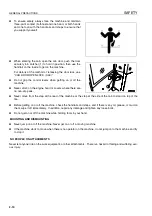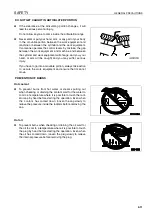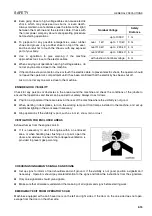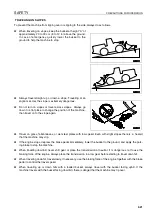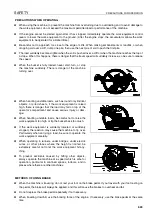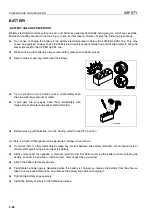
SAFETY
PRECAUTIONS FOR OPERATION
2-23
PRECAUTIONS WHEN OPERATING
q
When using the machine, to prevent the machine from overturning due to overloading and to avoid damage to
the work equipment, do not exceed the maximum permitted load or performance of the machine.
q
If the engine cannot be started again after it has stopped, immediately operate the work equipment control
levers to lower the work equipment to the ground. (After the engine stops, the accumulator allows the work
equipment to be operated for a limited time.)
q
Be careful not to approach too close to the edge of cliffs. When making embankments or landfills, or when
dropping soil over a cliff, dump one pile, then use the next pile of soil to push the first pile.
q
The load suddenly becomes lighter when the soil is pushed over a cliff or when the machine reaches the top of
a slope. When this happens, there is danger that the travel speed will suddenly increase, so be sure to reduce
the speed.
q
When the bucket is fully loaded, never start, turn, or stop
the machine suddenly. There is danger of the machine
turning over.
q
When handling unstable loads, such as round or cylindrical
objects, or piled sheets, if the work equipment is raised
high, there is danger that the load may fall on top of the
operator' compartment and cause serious injury or dam-
age.
q
When handling unstable loads, be careful not to raise the
work equipment too high or tip the bucket back too much.
q
If the work equipment is suddenly lowered or suddenly
stopped, the reaction may cause the machine to tip over.
Particularly when carrying a load, be sure to operate the
work equipment carefully.
q
When operating in tunnels, under bridges, under electric
wires, or other places where the height is limited, be
extremely careful not to let the work equipment hit any-
thing.
q
To prevent accidents caused by hitting other objects,
always operate the machine at a speed which is safe for
operation, particular in confined spaces, indoors, and in
places where there are other machines.
METHODS OF USING BRAKE
q
When the machine is traveling, do not rest your foot on the brake pedal. If you travel with your foot resting on
the pedal, the brake will always be applied, and this will cause the brakes to overheat and fail.
q
Do not depress the brake pedal repeatedly if not necessary.
q
When traveling downhill, use the braking force of the engine. If necessary, use the brake pedal at the same
time.
Содержание WA320-5H
Страница 2: ...FOREWORD 11...
Страница 17: ...CONTENTS FOREWORD 1 16...
Страница 23: ...CE CONFORMING EQUIPMENT FOREWORD 1 22...
Страница 24: ...SAFETY 12...
Страница 25: ...SAFETY 2 2...
Страница 60: ...OPERATION 13...
Страница 181: ...TROUBLESHOOTING OPERATION 3 122...
Страница 182: ...MAINTENANCE 14...
Страница 243: ...SERVICE PROCEDURE MAINTENANCE 4 62...
Страница 244: ...TECHNICAL DATA 15...
Страница 246: ...TECHNICAL DATA TECHNICAL DATA 5 3...
Страница 248: ...ATTACHMENTS OPTIONS 16...
Страница 313: ...CENTRAL LUBRICATION SYSTEM ATTACHMENTS OPTIONS 6 66...
Страница 314: ...INDEX 17...
Страница 315: ...INDEX 7 2...
Страница 318: ...NOTES 18...
Страница 319: ...NOTES NOTES 8 2 NOTES 8...
Страница 320: ...NOTES NOTES 8 3...
Страница 321: ...2003 Komatsu Hanomag GmbH All Rights Reserved Printed in Europe 10 2003...


